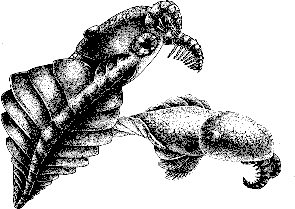BY LETTER
Anomalocaris
Aquatic Cambrian animal of uncertain affinities, the earliest known Terragen predator of its time. Anomalocaroids are neogens (usually crustacean-based) genesculpted to resemble Anomalocaris.
Although a popular subject for bioengineers, attempts to lazurogene the species proved completely unsuccessful, since there were no recent organisms to use as models. Eventually Paleoworld Disney raised a population of fake 2 meter specimens (actually heavily gengineered and prosthesitised Penaeid shrimps ) which proved to be a popular attraction. The Dinopark Institute came up with their own specimens that were even larger; these were based on lobster genome. By the middle Interplanetary Age the anomalocaroids faded into the background, as each theme park and orbital habitat try to upstage the next with newer, bigger, and more extravagant neogens.
The next time anomalocaroid-like splices appeared was during the middle Federation, when a number of templates were posted on the Planets-Wide Net both in the Sol System and as far away as Tau Ceti and the Eridanus League. A number of forms proved popular, including the Blue Monster, the Orange Dandy, and the Ceres Short-Armed Form, which while at 4.5 meters was not the largest breed by any means, nevertheless was robust, easy to care for, and could easily be interfaced with a good selection of Federation Biodyne and GeneTEK bioware.
By the Age of Emergence aquatic, amphibious, and even fully airborne microgravity anomalocaroids were ubiquitously found as pets, companion subsapients, and even guard bioborgs. The modular nature of several breeds, like the Eden Fantail, made provolution remarkably easy, although, because these were bioborgs and not authentic species, the Federation Provolution Institute had no jurisdiction (other than to ensure that the 'borgs were treated humanely), and things proceeded in an unsupervised manner, with each enthusiast preferring eir own way of doing things. At least three different species of large space-adapted bioborg anomalocaroid provolves were believed to have established feral populations along the frontier, and these cladized quite rapidly, developing into a host of exotic forms, including several species that developed a symbiotic relation with sapient bacteria, and the huge Cygnus Belt Leviathans, which became essentially autonomous, self-replicating and vacuum adapted bioships.
As with everything in the galaxy, anomalocaroids tend to go in and out of fashion every few centuries or so. Although subsapient, sophont, and even transingularity anomalocaroids can be found widely throughout the settled worlds, with thousands of different morphotypes and variations, they are not the most abundant of clades, although a modest estimate would give some 4 trillion subsapients (mostly as pets or hobby bioborgs), and about a fiftieth that number of sapients. Apart from the breeding season, they tend to be solitary creatures, although again this varies according to species and morphotype. A large population can be found among the Magal World Rings.
There are perhaps several hundred transingularitans current at any one time.
Appears in Topics
Development Notes
Text by M. Alan Kazlev
Initially published on 16 September 2001.
Initially published on 16 September 2001.







